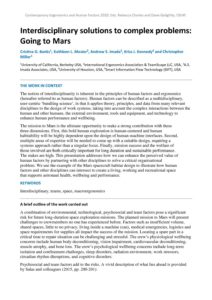| Document | Author Cristina G. Banks, Kathleen L. Mosier, Andrew S. Imada, Kriss J. Kennedy and Christopher Miller |
| Abstract The notion of interdisciplinarity is inherent in the principles of human factors and ergonomics (hereafter referred to as human factors). Human factors can be described as a multidisciplinary, user-centric ‘bundling science’, in that it applies theory, principles, and data from many relevant disciplines to the design of work systems, taking into account the complex interactions between the human and other humans, the external environment, tools and equipment, and technology to enhance human performance and wellbeing. The mission to Mars is the ultimate opportunity to make a strong contribution with these three dimensions. First, this bold human exploration is human-centered and human habitability will be highly dependent upon the design of human-machine interfaces. Second, multiple areas of expertise will be needed to come up with a suitable design, requiring a systems approach rather than a singular focus. Finally, mission success and the welfare of those involved are both critically important for long duration and sustainable performance. The stakes are high. This presentation addresses how we can enhance the perceived value of human factors by partnering with other disciplines to solve a critical organisational problem. We use the example of the Mars spacecraft habitat design to illustrate how human factors and other disciplines can intersect to create a living, working and recreational space that supports astronaut health, wellbeing and performance. |

